ISSN ONLINE(2278-8875) PRINT (2320-3765)
ISSN ONLINE(2278-8875) PRINT (2320-3765)
Ravinder K. Kharb1, Md. Fahim Ansari2, S. L. Shimi3
|
| Related article at Pubmed, Scholar Google |
Visit for more related articles at International Journal of Advanced Research in Electrical, Electronics and Instrumentation Engineering
Maximum power point tracking (MPPT) is used to increase the efficiency of solar photovoltaic (PV) systems under varying weather conditions. Conventional MPPT methods have drawbacks in terms of efficiency, accuracy, and flexibility. This paper presents the design and implementation of a maximum power point tracker that uses adaptive neuro fuzzy inference system (ANFIS). Open loop dc-dc boost converter is interfaced between solar PV module and resistive load. The duty ratio of boost converter is varied using ANFIS and PI controller in order to extract maximum possible power under varying solar irradiance and temperature. The simulated results of proposed tracker show improved performance in terms of oscillations about the maximum power point, speed, high gain and sensitivity to parameter variation. The simulation results of this research are presented to validate the concept
Keywords |
| Adaptive neuro fuzzy inference system (ANFIS), DC-DC boosts converter, Maximum power point tracking (MPPT), Photovoltaic (PV) module, PI controller. |
INTRODUCTION |
| Due to fast depletion of fossil fuel reserves and environmental degradation or legislative reasons, the interest in the utilization of renewable energy sources for electric power generation has increased. In order to meet the ever increasing energy demands globally, it is necessary to harness the renewable energy sources to their maximum potential for the purpose of electric power generation. Sunlight is an excellent renewable energy source which can be used for electric power generation without hampering the environment and the future of using solar power is very exciting. Solar energy offers a great potential for providing a carbon-free response to mankind’s energy demand. Unlike conventional energy sources, it is renewable, available everywhere for free, never-ending and helps to reduce the emission of green house gases that causes global warming [1]. |
| Solar PV systems use solar PV modules and arrays to directly convert solar energy into electric energy. However, low efficiency and high capital cost of solar PV systems are the main barriers for solar power installations across the globe [1]. The efficiency of solar PV system can be increased by extracting the maximum available power from the solar PV modules at different environmental conditions such as solar irradiance and temperature, using maximum power point tracker (MPPT). As the maximum available energy of solar PV module continuously changes with the atmospheric conditions, a real-time maximum power-point tracker is the indispensable part of the solar PV system. A maximum power point tracker is consists of a DC-DC converter and controller which always finds and maintains the operation of solar PV module at maximum power point using a tracking algorithm. Many MPPT algorithms have been presented in the literature [2-6] but most of them have limitations due to non-linear behaviour of solar PV module characteristics. Artificial intelligence (AI) based MPPT methods presented in literature [7-11] can track the maximum power point more efficiently under changing environmental conditions. AI based methods are most suitable for improving the dynamic performance of maximum power point tracking. Considering the non-linear characteristics of solar PV module, the AI methods provide a fast, flexible and computationally demanding solution for the MPPT problem. Fuzzy logic controller and artificial neural networks are two main AI methods used for MPPT. In this paper, designing and implementation of ANFIS based MPPT scheme which is interfaced with open loop boost converter is presented. ANFIS combines the advantages of neural networks and fuzzy logic and hence deals efficiently with non linear behaviour of solar PV modules. Designing of open loop DC-DC boost converter is also carried out which is used for impedance matching and maximum power transfer between load and solar PV module. |
ANFIS MODEL |
| Artificial intelligence systems are those systems which can make decisions like humans by adapting themselves to the situations and taking correct decisions automatically for future similar situations. Neural networks, fuzzy systems, and neuro-fuzzy systems are the examples of the artificial intelligence systems. The concept of fuzzy systems was described by Zadeh using fuzzy sets in 1965. The primary mechanism of fuzzy systems is based on conditional if-then rules, called fuzzy rules, which use fuzzy sets as linguistic terms in antecedent and conclusion parts. A collection of these fuzzy if-then rules can be determined from human experts or alternatively can be generated from observed data. The main advantage of such fuzzy systems is the easiness to interpret knowledge in the rule base. Neural networks are the systems that get inspiration from biological neuron systems and mathematical theories for learning. They are characterized by their learning ability with a parallel-distributed structure and also can be considered as black box modelling. |
| In neuro-fuzzy systems, neural networks are incorporated into fuzzy systems which can acquire knowledge automatically by learning algorithms of neural networks. Adaptive network based fuzzy inference system or adaptive neuro-fuzzy inference system (ANFIS), first proposed by Jang is one of the examples of neuro-fuzzy systems in which a fuzzy inference system is implemented in the framework of adaptive networks. ANFIS constructs an input output mapping based both on human knowledge (in the form of fuzzy if then rules) and on generated input output data pairs by using a hybrid algorithm that is the combination of the least-squares and backpropagation gradient descent method. In this paper ANFIS reference model is developed using ANFIS editor of Matlab/Simulink software package. |
METHODOLOGY |
| The block schematic of the maximum power point tracking scheme is depicted in figure 1 [12]. It is constituted of solar PV module, DC-DC boost converter, proportional integral (PI) controller, PWM signal generator and ANFIS reference model. |
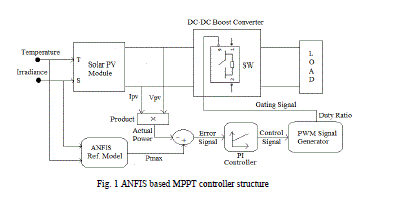 |
| Irradiance level and operating temperature are taken as the input for the ANFIS reference model. The ANFIS reference model gives out the crisp value of maximum available power from the PV module at a specific temperature and irradiance level. The actual output power from the PV module, at same temperature and irradiance level, is calculated by using multiplication algorithm on sensed operating voltage and currents. Two powers are compared and the error is given to a proportional integral (PI) controller, to generate control signals. The control signal generated by the PI controller is given to the PWM generator. The generated PWM signals control the duty cycle of DC-DC boost converter, in order to adjust the operating point of the PV module. |
IMPLEMENTATION OF ANFIS BASED MPPT |
| Flow chart for implementation of ANFIS based maximum power point tracker is shown in figure 2. First of all simulink model of solar PV module is developed using data specification of MXS 60 PV module given in table 1. Pair of input-output data sets under different weather conditions is collected using simulated model of solar PV module. |
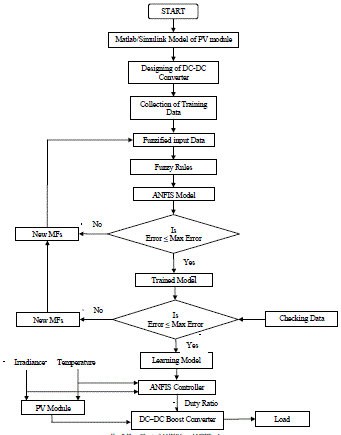 |
| Fig. 2 Flow Chart of ANFIS based MPPT scheme |
| This is training data set for ANFIS reference model. ANFIS is capable of developing the input-output mapping of training data sets when it is trained with sufficient number of epochs. By adjusting the values of membership functions, ANFIS generates the set of fuzzy rules in order to produce appropriate output for different values of inputs. Parameters of membership functions are adjusted or changed till the error is reduced to minimum value. Once all the parameters of membership function are adjusted, the ANFIS model becomes learning model which is ready to be used in MPPT control scheme. But before using ANFIS learning model for MPPT control, its results are checked by using checking data which is different from training data. Again if error produced is more than desired value, parameters of membership functions are adjusted to bring down the error. DC-DC boost converter is designed to be placed between solar PV module and load in order to transfer maximum power to load by changing duty cycle of dc-dc boost converter. |
A. Design of dc-dc boost converter |
| The DC-DC boost converters are used to convert the unregulated DC input voltage, supplied by PV modules, to a controlled DC output at a higher voltage level required by the loads. They generally perform the conversion by applying a DC voltage across an inductor for a period of time (usually in range of 20 kHz to 5 MHz) which causes current to flow through it and store energy magnetically, then switching this voltage off and causing the stored energy to be transferred to the voltage output in a controlled manner. The output voltage is regulated by adjusting the ratio of on/off time. This is achieved by using fast switching power components like IGBT or MOSFET which dissipate negligible power. Pulse-width modulation (PWM) allows control and regulation of the total output voltage. It is considered as the heart of the power supply, thus it will affect the overall performance of the power supply system. The ideal converter exhibits 100% efficiency; in practice, efficiencies of 70% to 95% are typically obtained. |
 |
| The boost converter configuration, as shown in figure 3, consists of a dc input voltage source Vs, boost inductor L, controlled switch SW, diode D, filter capacitor C, and load resistance R. DC voltage gain of the boost converter is given as |
| Where, Vs is input voltage, Vo is output voltage, and D is the duty cycle of the pulse width modulation (PWM) signal used to control the ON and OFF states of IGBT. Selection of different components of converter is done as follow |
(i) Selection of the inductor (L) |
| Large inductance values tend to increase the start-up time slightly while small inductance values allow the coil current to ramp up to higher levels before the switch turns off. Boost inductance is selected based on the maximum allowed ripple current at minimum duty cycle, D and at maximum input voltage, Vs. The boost converter operates in the continuous conduction mode for value of inductance L >Lb [13, 14] |
 |
| Where, Lb is the critical inductance, defined as the inductance at the boundary edge between continuous and discontinuous modes of converter; R is the equivalent load and fs is the switching frequency of IGBT. |
(ii) Selection of the capacitance required |
| The current supplied to the output RC circuit is discontinuous. Thus, a larger filter capacitor is required to limit the output voltage ripple. The primary criterion for selecting the output filter capacitor is its capacitance and equivalent series resistance (ESR). Since the ESR of capacitor affects efficiency, low-ESR capacitors should be used for best performance. The output filter capacitors are selected to meet an output voltage ripple specifications. Maximum ripple on the output voltage should not exceed a few percentages of the output voltage [15]. The minimum value of filter capacitor that provides the output DC current to the load when the diode is off is given by [13, 14] |
| Where, ΔVo is ripple on the output voltage which is usually selected in the range of less than 5% of the output voltage. |
| Minimum values of inductor and capacitor are calculated using equations (2) and (3). Actual values of inductor and capacitor, used in the simulation are kept higher than these values. Designed component values of DC-DC boost converter used for simulation are given in table 1. |
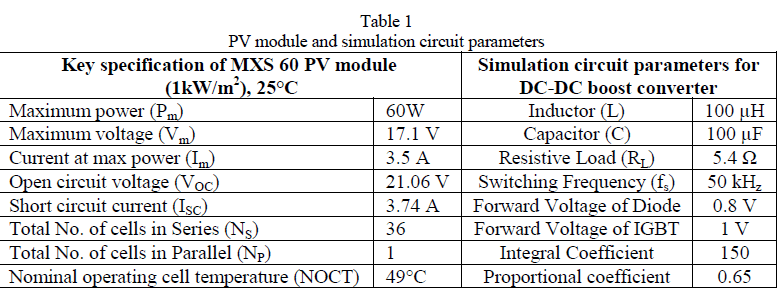 |
B. Design of ANFIS based MPPT |
| Matlab/Simulink model of PV module is used to generate the training data set for ANFIS by varying the operating temperature in steps of 5°C from 15°C to 65°C and the solar irradiance level in a step of 50 W/m2 from 100 W/m2 to 1000 W/m2. For each pair of operating temperature and solar irradiance, maximum available power of PV module is recorded. Thus in total 209 training data sets and 2000 epochs are used to train the ANFIS reference model. The training error is reduced to approximately 6%. ANFIS constructs a fuzzy inference system (FIS) by using input/output data sets and membership function parameters of FIS are tuned using the hybrid optimization method which is a combination of least-squares type of method and back propagation algorithm. The ANFIS structure developed by the Matlab code is shown in figure 4. |
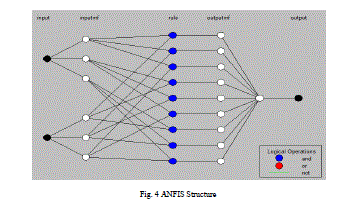 |
| It is a five layer network with two inputs (irradiance level and operating temperature) and maximum power as one output. Each input parameter has three membership functions which are learned by ANFIS method. According to input output mapping of data sets, nine fuzzy rules are derived so as to produce maximum output power for each value of input temperature and irradiance level. The ANFIS generated surface is shown in figure 5 which is a 3-dimensional plot between temperature, irradiance and maximum power. The ANFIS surface depicts that the maximum available power of solar PV module increases with increase in irradiance level and moderate temperature which verifies the non-linear behaviour of PV module. |
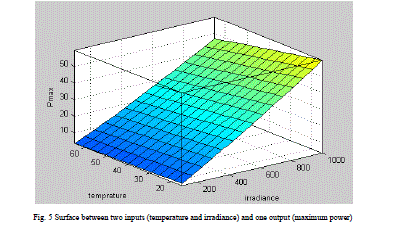 |
| Fig. 5 Surface between two inputs (temperature and irradiance) and one output (maximum power) |
| In the present work, ANFIS based MPPT is designed using user friendly icons from simulink library of Matlab. Pure resistive load 5.4 Ω is connected at the output, which closely matches the maximum power point of the solar PV module at 1000 W/m2 irradiance condition. Duty cycle of converter is varied with the help of an IGBT switch. A high carrier frequency pulse width modulator (PWM) block provides the gating signals to the IGBT. Simulated gated signals for boost converter are shown in figure 6. Crisp value of maximum available output power of PV module at a specific irradiance level and temperature is taken from the ANFIS reference model and it is compared with the actual output power taken from the simulated model of PV module. Difference of two powers is error signal which is processed by a proportional-integral (PI) controller and the resultant control signal is given to the PWM block to maintain the output power at maximum value. A carrier signal of frequency 50 kHz is used to generate the PWM signal. The PWM signal thus produced controls the ON and OFF time of IGBT as per the changing irradiance level and temperature, so as to maximize the output power of PV module. |
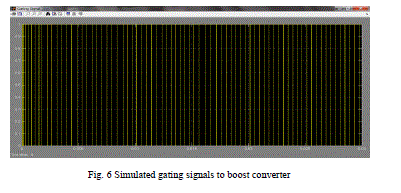 |
SIMULATED RESULTS |
| Proposed simulink model of ANFIS based MPPT control scheme with open loop DC-DC boost converter is tested under varying solar irradiance and temperature. Results are compared with the output of PV module when it is connected to load without MPPT control scheme. |
A. When irradiance level changes |
| Simulated results obtained under varying irradiance and constant temperature are given in table 2. A uniform increase in the output power is observed in table 2, when the irradiance level is increased at constant temperature. |
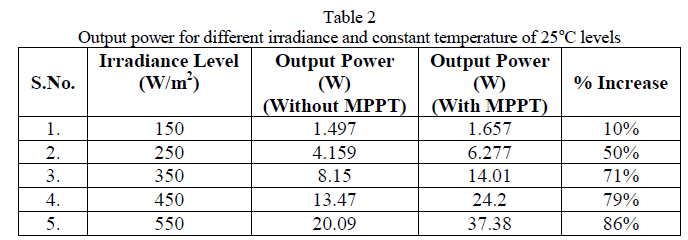 |
B. When operating temperature changes |
| The output power of PV module under varying operating temperature and constant irradiance level is given in table 3. It is observed that the output power does not deviate much from maximum value with the increase in temperature. It depicts the successful extraction of maximum available power of PV module under varying temperature. |
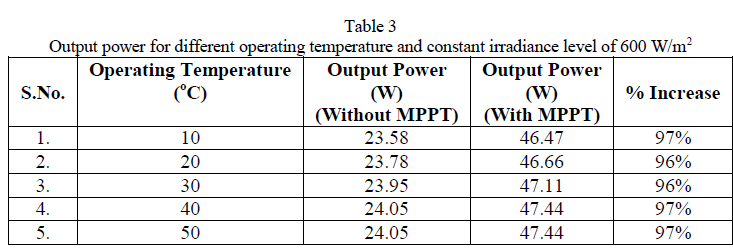 |
CONCLUSION |
| In this paper, design and implementation of ANFIS based MPPT control scheme with open loop boost converter is presented. The simulation of proposed control scheme is done using matlab software package and the operation is investigated under varying weather conditions. Simulation results reveals that ANFIS based MPPT control scheme is effective and efficient to track maximum available power from PV module under varying weather conditions. Particularly at low irradiance level, maximum output power can be tracked without producing oscillations. Response of proposed MPPT control scheme is significantly fast with high gain at all solar irradiance levels. |
References |
|